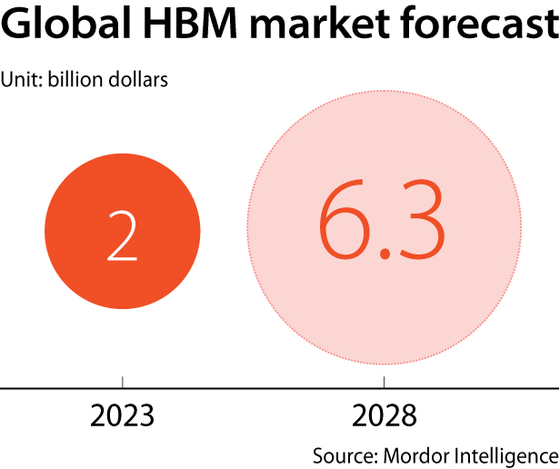Samsung, SK hynix battle for HBM supremacy
![SK hynix' high bandwidth memory (HBM) product HBM3 [SK HYNIX]](https://koreajoongangdaily.joins.com/data/photo/2023/07/17/3074d4f8-ea93-47ab-8b22-bcd1366e5133.jpg)
SK hynix' high bandwidth memory (HBM) product HBM3 [SK HYNIX]
High bandwidth memory (HBM) is now a major battleground between Samsung Electronics and SK hynix, with demand skyrocketing thanks to the increasing use of large-scale artificial intelligence systems such as ChatGPT.
HBM is a type of advanced memory chip that vertically stacks dynamic random-access memory (DRAM) dies in order to process more data quicker. They are deployed on a graphics processing unit (GPU) for AI.
As AI finds more usages, the HBM chips market is forecast to grow from $2 billion in 2023 to $6.3 billion in 2028, according to market tracker Mordor Intelligence.

As Samsung and SK expect huge losses in their memory chip businesses, the two companies are banking on the HBM to act as a new revenue stream, as these chips are at most six to seven times pricier than the widely used DDR4 (Double Data Rate 4) memory chips.
Samsung and SK currently account for more than 90 percent of the global HBM market, but the companies' individual market share differs depending on which company is providing the numbers.
Samsung Electronics CEO Kyung Kye-hyun claimed earlier this month that “Samsung’s HBM accounts for more than 50 percent of the market,” adding “the latest HBM3 products are getting positive feedback from clients.”
A week later, SK hynix held a close-door tech forum where it touted the technological supremacy of its own HBM products.
“SK hynix dominated the HBM market by collaborating with clients like AMD for a long time,” Samsung Securities analyst Hwang Min-sung, who attended the forum, said in a note.
“HBM is not a mass-produced item but is order-based which is why preemptive investment is vital,” Hwang added. “We don’t expect the HBM market share to change any time soon.”
SK hynix accounts for 53 percent of the global HBM market, according to TrendForce, followed by Samsung Electronics’ 38 percent and Micron’s 9 percent.
SK hynix is focusing on HBM3, the chip's fourth generation, which is being deployed on Nvidia’s latest GPU chipset H100.
“[SK hynix’s HBM products] differentiate themselves from others with what’s called MR-MUF technology, which applies liquid-type protections to circuits placed in between the chips,” a source from SK hynix said.
Samsung Electronics, on the other hand, is planning to integrate processing chips and advanced memory chips like HBM with 2.5D or 3D packaging technology. Samsung is able to do this as it is the only company globally that has a chip business portfolio spanning memory chips to contract-based processing chip fabrication and packaging.
Samsung plans to double the production capacity for its HBM products at its Cheonan factory in South Chungcheong.
However, overheated competition will do more harm than good for the overall chip industry, experts say, with HBM accounting for a mere 1 percent of the entire DRAM chip market.
“Instead of going head-to-head, chip industry players have played a seesaw game, going back and forth in developing technology and launching products and pulling the overall industry forward,” an industry insider said.
“The market leader can change at any time.”
Samsung Electronics’ chip business is expected to generate 14.7 trillion won ($11.6 billion) in operating loss this year, according to NH Investment &Securities, while SK hynix is forecast to post 11.2 trillion won of operating loss amid dwindling chip demand, according to IBK Securities.
BY CHOI EUN-KYUNG, KO SUK-HYUN [jin.eunsoo@joongang.co.kr]










with the Korea JoongAng Daily
To write comments, please log in to one of the accounts.
Standards Board Policy (0/250자)